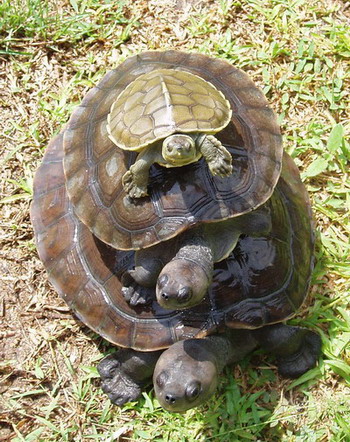|
| Query: hatchling | Result: 198th of 251 | |
Mangrove Terrapin (Batagur baska) - Wiki
| Subject: | Mangrove Terrapin (Batagur baska) - Wiki
| |

| Resolution: 350x442
File Size: 105608 Bytes
Date: 2006:05:10 11:10:26
Camera: u-miniD,Stylus V (OLYMPUS IMAGING CORP. )
F number: f/3.5
Exposure: 1/250 sec
Focal Length: 595/100
Upload Date: 2007:01:11 17:20:12
|
Batagur baska
From Wikipedia, the free encyclopedia
[Photo] northern river terrapins of different age cohorts: (from top to bottom) hatchling of about a week old, one year old and two years old. Picture taken by author. No river terrapins were harmed or hurt in the process of taking this picture. Image was also uploaded to Flickr (http://static.flickr.com/81/324890844_ec49e838ef_o.jpg).
The Batagur or mangrove terrapin (Batagur baska) is a species of riverine turtle. It is one of the most critically-endangered turtle species according to a 2003 assessment by the IUCN. Batagur baska is a rare and endangered Asian river terrapin also called the "Royal Turtle" in Cambodia because its eggs were a royal delicacy.
Description
Carapace moderately depressed, with a vertebral keel in the young, which keel disappears in the adult; nuchal broader than long; first vertebral as broad in front as behind, or a little broader; vertebrals 2 to 4 subequal, much broader than long in the young, nearly as long as broad and as broad as the costals in the adult, the postero-lateral border of the third vertebral strongly concave. Plastron large, strongly angulate laterally in the young, convex in the adult, truncate anteriorly, angularly notched posteriorly; the width of the bridge exceeds the length of the posterior lobe; the longest median suture is that between the abdominals, the shortest that between the gulars, the latter never more than half that between the humerals; inguinal large, axillary smaller. Head rather small; snout pointed, produced, directed upwards; jaws with denticulated edge, upper feebly notched mesially; the width of the lower jaw at the symphysis nearly equals the diameter of the orbit. Limbs with transversely enlarged, band-like scales. Maximum carapace length is 60cm. Upper surface of shell and soft parts olive-brown, lower surface yellowish.
Distribution
The Batagur is found only in parts of India such as Bengal, Bangladesh, Myanmar, Thailand, Vietnam, Peninsular Malaysia (Kedah, Perak and Terengganu), Sumatra, Indonesia and Cambodia (Cardamom Mountains), and populations have been sharply declining in recent years.
Decline
Many Asian turtles are in danger because of the thriving trade in animals in the region, where a species' rarity can add to its value on a menu or as a traditional medicine.
The species was thought to have disappeared in Cambodia until it was rediscovered in 2001. Conservationists eventually began tagging the animals with tracking devices and monitoring their nests, and King Norodom Sihamoni personally ordered their protection.
In Malaysia, rivers of Kedah, Perak and Terengganu are major nesting grounds though the population continues to crash despite conservation efforts undertaken by Malaysian Wildlife Department for over 20 years. Pasir Temir and Pasir Lubuk Kawah by the Terengganu River are the largest nesting sites for Batagur baska in the world.
http://en.wikipedia.org/wiki/Batagur_baska
| The text in this page is based on the copyrighted Wikipedia article shown in above URL. It is used under the GNU Free Documentation License. You may redistribute it, verbatim or modified, providing that you comply with the terms of the GFDL. |
|
^o^
Animal Pictures Archive for smart phones
^o^
|
|

